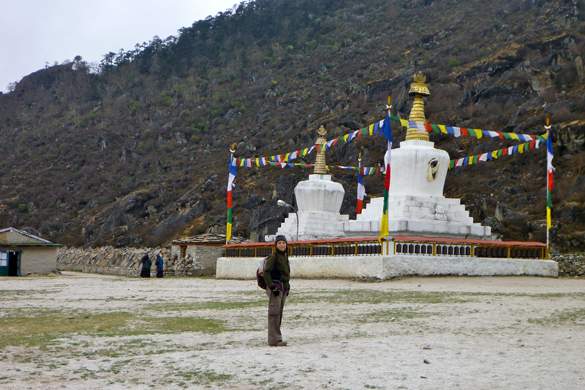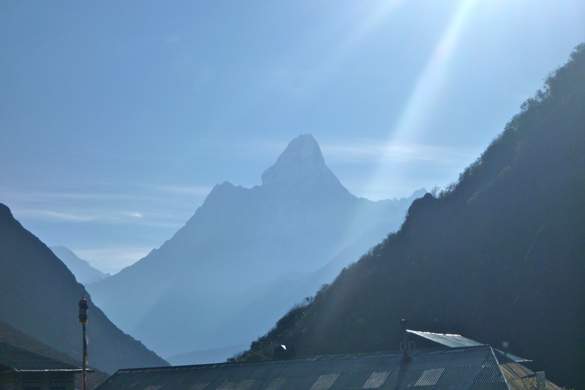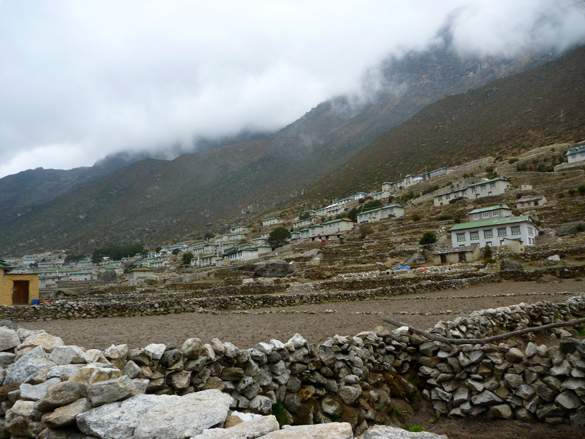The walk up to Tengboche was tough enough. The lodge was crap, and the night that followed, extremely cold. It didn’t help that sometime around midnight I discovered my rented sleeping bag was devoid of down filling in the sections between my hips and knees. The smell of sewage from the unclean squat toilet hung in the thin air as a constant reminder of where I was. I tossed and turned most of the night and needless to say, woke up in a rotten mood.
I was cranky because I had been fairly uncomfortable during the night, but also because my time climbing to new heights was over. I would be turning around this morning and heading back down towards Lukla. And, despite my trouble getting a full night’s sleep, I felt okay. Sure, my body was tired and sore, but as far as the altitude was concerned, it was not really affecting me. I sat with a woman from San Jose at breakfast who was so ill I couldn’t believe her guide was pushing her to go higher. I had expected to get sick, and embarked on the trek armed with Diamox and a satchel of other remedies. Turns out, at least at almost 13,000 feet, I needed none of them. I wanted to keep going and was disappointed that I couldn’t. (Though after one night shivering in my sleeping bag, I kind of knew going higher could result in frostbite.) The walk down would be long; I wanted to eat breakfast and get on with it.
And so less than 16 hours after I’d dragged my ass up the steep pass into Tengboche, I was about face and descending it. My mood continued to drop with the trail, especially since my Sherpa guide Phurba virtually vanished. He’d just skip along, way ahead of me until he was out of sight, then stop and wait for me at 30 minute intervals.
“Is problem? Knee is paining?” he said when I caught up with him at a natural resting point.
Let’s see, I was moving at the pace of an arthritic geriatric patient, wincing with each step, holding up traffic, watching my knee swell – “Yes, Phurba, IT’S PAINING.” While I had told him to go ahead the previous day, no such words had been uttered today. I was scared I might fall and break my leg, and he’d be nowhere in sight. What if I had to be carried down by the smelly porters, or worse, strapped to the back of a yak for the two day hike to an airstrip? With these doomsday scenarios whizzing through my head, I gobbled some Advil and got down the pass as quickly as I could.
We were headed to Khumjung, a Sherpa village near Namche Bazaar. Most trekkers visit Khumjung during a rest/acclimatization day on their way up to Everest Base Camp, but I’d arranged to spend the night on my way back to Lukla. Like Namche, it is a village carved into the mountainside, reminiscent of an ancient Greek amphitheater. We arrived sometime in the early afternoon to the eerie feeling that Phurba and I were the only people in town. Aside from the school kids kicking around a deflated soccer ball (following his ascent of Everest, Sir Edmund Hillary built a school in Khumjung, as well as hospital nearby), I saw nobody. I asked Phurba what was up, and he told me that most of the climbing Sherpa came from Khumjung. The ones lucky enough to land a place on an expedition were high up on Everest working, probably already plotting for the summit. Some, he solemnly remarked, would not return. Where their wives and families were, I wasn’t sure.
Aside from climbing Sherpa and Hillary’s school, Khumjung has another claim to fame, one which would take me by surprise. The village houses an old Buddhist monastery, and Phurba (who confessed that he would one day like to land a job as an Everest Sherpa) wanted to visit and ask the Buddha to keep safe his colleagues who were headed up to the death zone. I was more than happy to take a walk over with him; I felt pretty good.
The village was not as steep as Namche, and it was an easy and charming walk. Aside from a couple of nuns cleaning the prayer wheels, the only people there were Phurba, a monk who showed us around, and me. As I always do, I put a few rupees in the donation box. The monk came scurrying over to me and took me by the wrist. He led me to a locked cabinet and took out the key. Was he trying to extort more cash? Is that where the “real” donations were kept? I did not know what was going on. Phurba had a giant grin on his face and asked me if I was ready. Confused and a little bit scared, all I could muster was an unsure, “Sure…” Inside the cabinet, resting atop a ’50s-style beauty school bust sat the monastery’s prized earthly possession: the scalp of a yeti.
Now of course, as luck (and legend) would have it, I had left my camera at the lodge. The innkeeper had electricity behind the counter and was charging my battery. As in life, the yeti is apparently camera shy in death. Nobody was going to believe me. Hell, I could not even believe it myself. I asked the monk if he had seen a live yeti, and with what frequency. He told me that it was very rare now but when he was a boy he would see them often. He did say that weather like today’s (cold, foggy, gray) sometimes brought one around this time of year, looking for food. Interesting stuff. I wondered how tall the tales would grow if I’d made a larger donation. I turned a couple prayer wheels and retreated to the warmth of my guest house.
The date was April 30th, one day before the May Day celebrations. We knew this was a national holiday of sorts, and we also knew, via news trickling up and down the trail, that May 2nd was going to be a day of Maoist demonstrations. I was set to fly back to Kathmandu and start volunteer work on May 3rd. All sorts of rumors were flying around, and I was overjoyed when we got back to the tea house to find the soothing sounds of Nepali screaming out of a television set. I ordered a lemon tea and took a seat next to a couple from Arizona I’d met a few days earlier. Happy to be in the company of Americans, we quickly got to talking. Rumors had been flying and we were trying to discern what was actually going on. It’s no secret that Nepal suffers from bouts of political instability. There was chatter up and down the trail; rumors of airports closing, imminent riots, martial law, mass starvation. Up here in Khumjung, the demonstrations in the capitol mattered little. All any of us really wanted to know was would we be stranded in the Himalayas, and for how long. As I don’t speak Nepali, watching TV was little comfort. There were shots of the Prime Minister and the Maoist leader, but not one of the 10 Sherpa or porters would translate anything for us.
I kept asking Phurba, “so, what is going on? Is the domestic airport going to close? How will we get back to Kathmandu? Will we have to walk?” (This was a real possibility – and one that would take over a week.)
Some people speculated that the protests/strike would go on for a month. Problem was, the Nepalis are so used to it, they really didn’t seem to care too much. They also did not want to relay any bad or disappointing news to foreigners, lest we think poorly of their country, so instead all we got was nebulous information. “Maybe will be OK I think,” or “He is Maoist leader, is saying protest tomorrow.” Gee, thanks guys. Informative and reassuring.
As I passed the time talking with my new friends Lisa and Kris about home – turns out the couple had recently been to a wedding at The Brownstone in NJ, where my sister got married; Lisa’s family was from NJ and Italian; they had both eaten the spaghetti for lunch and recommended I try it for dinner – some excitement arose from the Sherpa gang, who were all crowding closer to the TV. Excellent, I thought, some news. The scene that we witnessed was so unbelievably bizarre that had I been alone, I’d have assumed I was having high altitude hallucinations. Every Nepali in the room (save for the woman who ran the lodge) had moved his chair close to the TV. The volume was turned way up. As the sun set behind the Khumbu range, we, along with probably the only other people in town, settled in for a three hour long session with the WWE. Wrestlemania had reached one of the most remote parts of the world, and carried with it far more weight than something so futile as, oh, a Maoist-imposed national strike!
This was serious business. The thin air suddenly became thick and heavy, as if the Sherpa were high rollers with millions resting on the Kentucky Derby. Having worked in heavy metal, I was embarrassed to admit I knew some of the wrestlers and moreover their theme songs. I was hearing Killswitch Engage (a band I used to represent) at 13,000 feet. I had even met a couple of the wrestlers, news I kept to myself lest a riot break out. The excitement in the room was bananas. At one point, Phurba got so worked up his chair was rattling. I asked if the featured wrestler (I think it was Darren Young) was his favorite. “Oh yes, He is very good player!” and then I was shushed so the match could be watched in silence. It was truly hilarious, and I had not laughed that hard in a long time. Proud of my country’s fine entertainment exports, I focused my thoughts on dinner.
I have to admit, I was nervous about ordering the spaghetti. It was on every menu, but I usually thought it best to stick with dal bhat. We had been talking about food all afternoon, and I was sick of dal bhat. My friends assured me that it was a good choice. So after the innkeeper fired up the stove with yak dung, she went to work (sans washing her hands, I should note) chopping up fresh tomatoes, onions and garlic, and I was presented with a giant plate of spaghetti with fresh marinara sauce and a heaping mound of grated yak cheese. And it was actually delicious. I declined to accept Kris’s recommendation to sample the “Hot Tang,” (by far the most curious menu item I had seen on the trek) but thought that if I ever started a band, that would be a great name. The afternoon turned into evening, the Wrestlemania marathon carried on long past sunset and my last day high in the Himalayas was a blast.
I was in bed by 8PM, haunted by dreams of being abducted by a spaghetti-eating, tang-drinking, Maoist-wrestling yeti. Bizarre, indeed.


